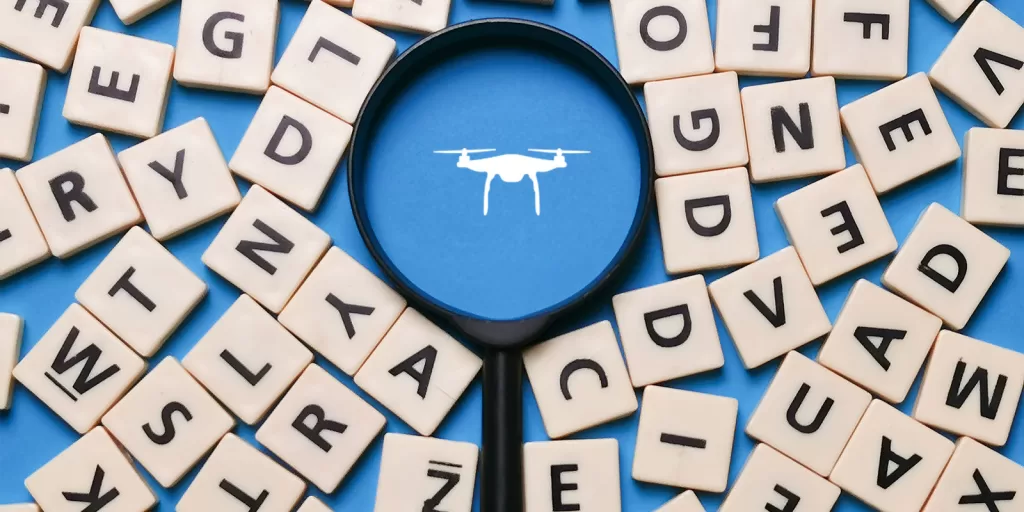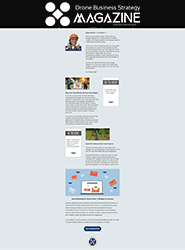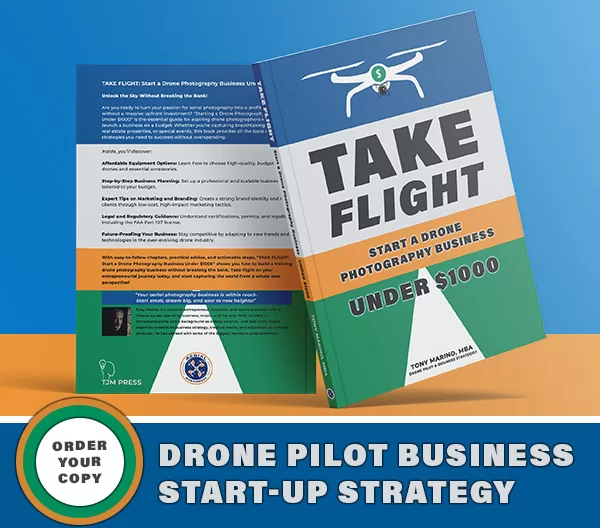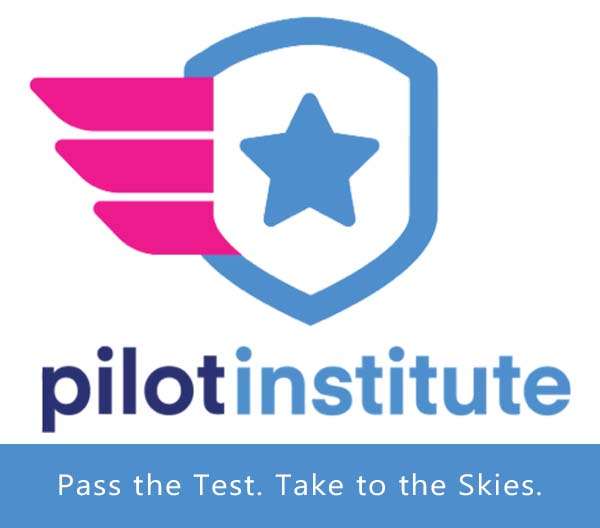
In the rapidly growing world of commercial drones, knowledge is your most potent asset. As a commercial drone pilot, understanding the terminology that surrounds this innovative industry is not just an intellectual pursuit; it’s a crucial operational strategy. From ensuring safety and compliance to communicating effectively with clients and colleagues, knowing the language of drones is paramount to your success.
In this article, we present a comprehensive glossary that deciphers the intricate lexicon of drones and Unmanned Aircraft Systems (UAS). Whether you’re a seasoned professional or just starting your journey into the world of commercial drone operations, mastering these terms will give you a competitive edge and contribute significantly to your business strategy.
Why Understanding Drone Terminology Matters:
- Safety First: Safety is the cornerstone of any successful drone operation. Understanding terms like “Fail Safe,” “Geofencing,” and “Sense and Avoid” ensures that you can navigate your drone safely, prevent collisions, and respond effectively to emergencies. This knowledge is your safeguard against accidents and liability.
- Regulatory Compliance: Regulatory bodies like the Federal Aviation Administration (FAA) in the United States have specific terminology embedded in their regulations, such as “Part 107” for non-hobbyist operations. To stay compliant and operate legally, you must be fluent in this regulatory language.
- Client Communication: Clients often rely on your expertise to understand the capabilities and limitations of drone technology. Explaining terms like “LiPo Battery” and “Waypoint” in plain language can instill confidence in your clients and help manage their expectations.
- Operational Efficiency: Drones are powerful tools that can streamline various industries, from agriculture to construction. Knowing terms like “Payload” and “GPS” will enable you to harness the full potential of your drone, optimizing its use for specific applications.
- Problem-Solving: Drones are not immune to technical issues. When something goes wrong, understanding terms like “Gimbal” and “Firmware” will empower you to troubleshoot effectively, reducing downtime and preventing costly repairs.
- Staying Competitive: In a competitive market, knowledge sets you apart. As clients seek experienced and knowledgeable pilots, your fluency in drone terminology can be a key selling point. It demonstrates your commitment to professionalism and excellence.
Now, let’s delve into the drone glossary, equipping you with the terminology you need to succeed in the commercial drone industry.
By the Numbers
2.4 GHz Spread Spectrum: Gigahertz (GHz) describes the radio frequency rate used by a drone controller. The 2.4 GHz spread spectrum controllers are known for their agility in hopping to different frequencies to ensure stable communication, reducing the risk of crashes.
5.8 GHz: This frequency is used in hobby and professional-grade RC drones, offering a live feed with better range and less lag. It’s particularly popular in First-Person View (FPV) racing, often paired with FPV goggles.
808 Camera: A term for small, lightweight cameras, often referred to as “keychain cameras,” commonly used by hobbyists to capture images from multi-rotor aircraft.
250 Racer: A racing multicopter with a diagonal measurement of 250mm, commonly used in FPV racing.
(A)lpha – (D)elta
Accelerometer: A device that measures acceleration forces, aiding in drone orientation and stability. Accelerometers are crucial for stabilizing quadcopters.
Aerial Photography: The art of capturing images and videos using cameras mounted on drones while they are airborne.
AGL (Above Ground Level): Altitude measured above the ground level.
Altitude Hold Function: This feature allows a drone to hover steadily at a set height, enabling the pilot to focus on capturing images or videos. It often relies on barometric pressure sensors.
Autopilot: A drone’s capability to conduct flights without real-time human control, often following preset GPS coordinates. Autopilots assist rather than replace human operators.
Autonomous Flight: Some UAS are guided by internal software instructions, often using GPS for navigation. Non-autonomous flight involves radio control from the ground.
Axis: A plane of potential flight. Most multirotor UAVs have at least four axis controls, with six or more being preferred.
Balanced Battery Charger: A charger that manages and balances the multiple cells within a lithium polymer (LiPo) battery, ensuring safe and efficient charging.
Barometric Pressure Sensor: A device that uses barometric readings to determine the aircraft’s altitude above ground level, contributing to altitude hold.
Battery: Powers various components onboard a drone, including the flight controller, receiver, FPV transmitter, and rotors.
Bind: The process of establishing communication between the controller (transmitter) and the drone, often used to link software-controlled objects.
Brushless Motor: Efficient and durable motors with permanent magnets, commonly used in drones for propulsion.
BVLOS (Beyond Visual Line of Sight): Flying a drone beyond the operator’s direct line of sight.
Carbon Fiber: A lightweight, strong, and durable composite material used in building drone frames and components.
Channel: Refers to the frequency used by an FPV transmitter or an assigned function linking a controller transmitter with a drone, such as throttle or light control.
Collision Avoidance: Systems in UAVs designed to prevent collisions with objects or other aircraft during flight.
Controller (or Flight Controller): A handheld device used by the pilot to control the drone, which can range from basic radio transmitters to sophisticated devices equipped with accelerometers, GPS, and other sensors.
Drone: Also known as Unmanned Aerial Vehicles (UAVs), drones are aircraft operated remotely, either by pilots on the ground or autonomously through pre-programmed missions.
(E)cho – (G)ulf
Electronic Speed Control (ESC): A device that controls an electric aircraft’s motor and power distribution, typically including a Battery Elimination Circuit (BEC) for powering onboard electronics.
FAA (Federal Aviation Administration): The United States Department of Transportation agency responsible for regulating and overseeing civil aviation.
Fail Safe: A system that protects a drone in case of errors, such as returning to the takeoff point when it loses control signal.
FAR (Federal Aviation Regulation): Regulations governing aviation in the United States.
Field of View (FOV): The measurement of how much of the environment is visible through a camera lens, often expressed in degrees.
First-Person View (FPV): A method of flying where the drone operator sees real-time camera footage, typically using goggles or a display.
Firmware: Software loaded into a drone’s non-volatile memory, determining its behavior and functionality.
Flight Control System: An interconnected network of controls that allows the pilot to maneuver the drone.
Fly Away: Unintended flight beyond operational boundaries due to control or system failures.
FPV Camera: A specialized camera used for first-person-view flying, photography, or videography.
FPV Goggles: Specialized goggles that display the live camera feed to the operator during FPV flight.
FPV Racing: A sport where pilots race small quadcopters around a predetermined track.
Frequency: The radio band on which FPV equipment operates, with multiple channels to prevent interference.
Geofencing: Using GPS technology to create virtual geographic boundaries for drones, triggering responses when they enter restricted areas.
Gimbal: A mount for a camera that allows it to swivel and tilt, providing stabilized footage even as the drone moves.
GIS (Geographic Information System): A system for capturing, storing, and analyzing spatial or geographic data.
GPS (Global Positioning System): Used to track an object’s position relative to global spatial coordinates or maintain an airborne vehicle’s position.
Ground Control Station: Software running on a computer to receive telemetry and display status, often used for transmitting in-flight commands.
Gyroscope: Measures rotation rate and helps maintain the orientation of a quadcopter during flight.
(H)otel – (L)ima
Hexicopter: A multi-rotor aircraft with six rotors, capable of maintaining control even if one engine fails.
Hobbyists: Noncommercial drone pilots who operate UAVs domestically under certain altitude and line-of-sight restrictions.
Inertial Measurement Unit (IMU): Combines an accelerometer and a gyro to assist in drone orientation and stabilization.
Inertial Navigation System (INS): Calculates position based on initial GPS readings, followed by speed and motion sensor data when GPS signal is lost.
Intelligent Orientation Control (IOC): Allows the drone’s forward direction to be independent of its nose direction.
LAANC System (Low Altitude Authorization and Notification Capability): A system that provides real-time processing of airspace notifications and approval for drone flights in controlled airspace.
Landing Gear: The undercarriage of an aircraft that supports it while on the ground.
LCD Monitor: A screen, often attached to the controller, used to view the drone’s camera feed, an alternative to FPV goggles.
Line of Sight (LOS): The ability to see the drone with the naked eye from the operator’s position.
LiPo (Lithium Polymer) Battery: A lightweight and high-capacity battery type commonly used in drones.
Lithium Polymer Battery: A battery chemistry known for being lightweight and powerful, used in drones for efficiency.
(M)ike – (P)apa
mAh (milli Amp Hours): A unit of measurement describing a battery’s capacity before needing a recharge.
Modifications: Changes made to drones to integrate new functions or features.
Mode 1 Transmitters: Transmitters with throttle control on the right stick, popular in the UK.
Mode 2 Transmitters: Transmitters with throttle control on the left stick, popular in the USA.
Multicopter: A generic term for drones with multiple propellers, also known as rotors, including tricopters, quadcopters, hexacopters, and octocopters.
Multi-Rotor Copters: UAVs featuring multiple rotors, including drones, quadcopters, quadricopters, and quadrocopters.
Nano: Extremely small drones that can fit in the palm of your hand and are suitable for indoor flight.
National Airspace System (NAS): The airspace, navigation facilities, and airports of the United States, regulated by the FAA.
NAZA: A flight controller used on DJI Phantom Drones, equipped with key sensors for control.
No-Fly Zone: Areas where drone flights are restricted by government regulations to prevent interference with aircraft or sensitive information.
Octocopter: A drone with eight horizontal propellers or rotors.
On-Screen Display (OSD): A screen that provides flight data such as speed, battery life, and heading.
Part 107: Refers to CFR Part 107 of the FAA, which covers regulations for non-hobbyist unmanned aircraft operations in the United States.
Payload: The additional weight a drone can carry in addition to its own weight and batteries, such as cameras or sensors.
Pilot in Command (PIC): The person responsible for the drone’s operation and safety during flight.
Pitch: A measure of flight angle along one axis, typically measured from level, indicating forward and backward motion.
Pre-Flight Planning: Activities conducted before takeoff to ensure a safe flight, including checking weather, routes, equipment, and more.
Power Distribution Board (PDB): A board used to distribute power to each motor in a multicopter, ensuring proper stabilization.
Prop: Short for propeller, the component responsible for generating thrust in drones.
(Q)uebec – (T)ango
Quadcopter or Quad: A UAV with four rotors, each with its own motor and propeller, commonly found in drones like the DJI Phantom.
Raceband: A set of 5.8 GHz frequencies commonly used in drone racing to avoid interference.
Radio: A device that broadcasts on a specific frequency or channel to control a drone’s pitch, yaw, and roll direction.
Radio Controller: A wireless handheld device used to control a drone’s flight.
R/C (Radio Controlled): A synonym for radio-controlled, referring to devices and systems used in remote control.
Receiver: Accepts the camera’s feed and relays it to a screen or goggles for viewing.
Return to Home: A GPS feature that autonomously guides the drone back to its takeoff point.
Rx (Receiver): An abbreviation for receiver, which receives and processes control signals from the transmitter.
Sense and Avoid: A drone’s ability to detect and avoid collisions with other airborne objects.
Servo: A servomotor used in aerial vehicles for various functions like camera panning and wing flap control.
Spotter: A person who keeps visual track of the drone during FPV flight, alerting the pilot to potential hazards.
sUAS (Small Unmanned Aircraft System): Refers to drones weighing under 55 pounds.
Telemetry: Data related to various aspects of a flying drone, including speed, altitude, pitch, roll, yaw, battery life, and position.
Throttle: A control that influences the speed of electric motors, generating thrust in drones.
Thrust: The force generated by a propeller and motor combination, responsible for lifting the drone into the air.
Transmitter: A device that sends commands to the drone from the pilot or relays the camera feed to the receiver.
Trim: A setting that adjusts how a drone hovers in the air, helping it maintain its position.
TX (Transmitter): An abbreviation for transmitter, which sends control commands to the drone.
(U)niform – (Y)ankee
UA (Unmanned Aerial): A description often followed by “S” for systems or “V” for vehicles, describing remotely operated aerial systems.
UAS (Unmanned Aerial Systems): A term used to emphasize that a UAS includes various elements beyond the UAV itself, such as support equipment, applications, and networking components.
UAV (Unmanned Aerial Vehicle): A device that can fly without a human pilot onboard, encompassing drones and quadcopters.
Ultrasonic Sensor: A sensor using ultrasound waves to measure the distance to the ground, useful for drones in maintaining altitude.
UTM (Unmanned Traffic Management): A cloud-based system developed by NASA to manage low-altitude airspace and prevent collisions between unmanned and manned aircraft.
Video Latency: The delay between what a camera sees and when it is displayed on a monitor or goggles.
Visual Line of Sight (VLOS): The ability to see the drone from the ground with the naked eye, often a regulatory requirement.
Visual Observer: A crew member who assists the UAS pilot in collision avoidance and other duties, often associated with FPV flying.
Waiver: An authorization issued by the FAA, granting exemptions to certain Part 107 requirements for safe drone operations.
Waypoint: A set of coordinates defining a specific point in space, crucial for planning autonomous drone missions and mapping.
Wi-Fi FPV: A feature found in many drones, allowing users to view a live feed via a downloadable app on Android/iOS smartphones and tablets.
Yaw: The rotation of a quadcopter around its center axis on a level plane, affecting its direction.
This extensive glossary provides insight into the terminology used in the exciting world of drones and Unmanned Aircraft Systems (UAS). Whether you’re a drone pilot, enthusiast, or simply curious about this technology, understanding these terms is essential for safe and effective operation in this rapidly evolving field.
Conclusion: The Takeaway
The world of commercial drones is dynamic and exciting, but it demands professionalism, safety, and expertise. Your journey to becoming a successful commercial drone pilot starts with mastering the language of drones. The comprehensive glossary provided in this article equips you with the knowledge you need to operate safely, navigate regulations, communicate effectively, and optimize your drone’s capabilities.
Remember, understanding drone terminology is not just about words; it’s about empowering yourself to make informed decisions, provide superior service to your clients, and stay competitive in a rapidly evolving industry.
So, embrace this glossary, continue learning, and let your expertise soar to new heights in the world of commercial drones. Your success depends on it.
Be smart, safe, and forever fly!
If you have any questions, let us know! If you’d like to hire us, you can get more information here.
Written by: Tony Marino, MBA – FAA Certified Part 107 Commercial Drone Pilot and Chief Business Strategist at Aerial Northwest
Disclaimer: The information provided in this blog post is for general informational purposes only and should not be construed as legal advice.
Starting Your Own Drone Service Business
Pick up your copy today on Amazon and wherever fine books are sold.

DRONE BUSINESS STRATEGY MAGAZINE
A free digital publication made exclusively for all small business drone pilots to them help start-up, become profitable while sustaining a competitive advantage within the drone service industry sector they opt to serve.
“If you love to fly, we’d love to have you come aboard!”
We share your information with no one. Our Privacy Policy.










Leave a Reply
Your email is always safe with us.